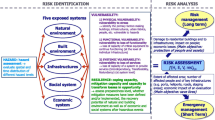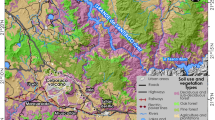Abstract
To help improve the safety of its population faced with natural disasters, the Cameroon Government, with the support of the French Government, initiated a programme of geological risk analysis and mapping on Mount Cameroon. This active volcano is subject to a variety of hazards: volcanic eruptions, slope instability and earthquakes. Approximately 450,000 people live or work around this volcano, in an area which includes one of Cameroon’s main economic resources. An original methodology was used for obtaining the information to reply to questions raised by the authorities. It involves several stages: identifying the different geological hazard components, defining each phenomenon’s threat matrix by crossing intensity and frequency indices, mapping the hazards, listing and mapping the exposed elements, analysing their respective values in economic, functional and strategic terms, establishing typologies for the different element-at-risk groups and assessing their vulnerability to the various physical pressures produced by the hazard phenomena, and establishing risk maps for each of the major element-at-risk groups (population, infrastructures, vegetation, atmosphere). At the end of the study we were able (a) to identify the main critical points within the area, and (b) provide quantified orders of magnitude concerning the dimensions of the risk by producing a plausible eruption scenario. The results allowed us to put forward a number of recommendations to the Cameroon Government concerning risk prevention and management. The adopted approach corresponds to a first level of response to the authorities. Later developments should make it possible to refine the quality of the methodology.








Similar content being viewed by others
References
Ambeh WB, Fairhead JD (1991) Regular, deep seismicity beneath Mt. Cameroon volcano: lack of evidence for tidal triggering. Geophys J Int 106:287–291
Ateba B, Ntepe N (1997) Post-eruptive seismic activity of Mt Cameroon (Cameroon), West Africa: a statistical analysis. J Volcanol Geotherm Res 79:25–45
Ayonghe SN, Ntasin EB, Samalang P, Suh CE (2004) The June 27, 2001 landslide on volcanic cones in Limbe, Mount Cameroon, West Africa. J Afr Earth Sci 39:435–439
Blong RJ (1984) Volcanic hazards—A sourcebook on the effects of eruptions. Academic Press, Sydney, 424 pp
Bulourde M (2001) Processus d’altération des basaltes du Mont Cameroun: Approche géochimique. Thesis, University of Rennes 1 (France), 100 pp
Cronin SJ, Hedley MJ, Neall VE, Smith RG (1998) Agronomic impact of tephra fallout from the 1995 and 1996 Ruapehu Volcano eruptions. N Z Environ Geol 34(1):21–30
Cruz Mermy D, Lambert A, Thierry P, Stieltjes L, Kouokam E, Nni J, Ngueya P, Salley MP, Nkoumbou C, Thieblemont D (2006) Projet GRINP Composante 1—Notice des cartes géologiques du Mont Cameroun. BRGM Report RP54726-FR, Orléans, 216 pp
Déruelle B, Bardintzeff JM, Cheminée JL, et al (2000) Eruptions simultanées de basalte alcalin et de hawaiite au Mont Cameroun, 28 mars–17 avril 1999. Comptes rendus de l’Académie des Sciences, Série II. Sciences de la terre et des Planètes 331(8):525–531
Déruelle B, N’ni J, Kambou R (1987) Mount Cameroon: an active volcano of the Cameroon Line. J Afr Earth Sci 6:197–214
Dumort JC (1968) Carte géologique de reconnaissance de la République Fédérale du Cameroun, Douala-Ouest, 1/500 000. Cameroon Mines and Geology Directorate, 1 map, 1 explanatory note, 69 pp
Hedberg JD (1968) A geological analysis of the Cameroon trend. Ph.D. thesis, University of Princeton, New Jersey (USA), 414 pp
Kouokam E (2001) Monitoring of Mount Cameroon impact risk assessment—site response analysis (Muea-Bokova-Buea-Bakingili-Ngeme area) 1st campaign. Cameroon ministry of mines, water and energy report, 105 pp
Léone F (1995) Concept de vulnérabilité appliqué à l’évaluation des risques générés par les phénomènes de mouvements de terrain. Doctoral thesis, Joseph Fourier University, Grenoble (France), 274 pp
Nkoumbou C, Déruelle B, Velde D (1995) Petrology of Mt Etinde Nephelinite series. J Petrol 36(2):373–395 (Oxford University Press)
Nni J (1984) Le volcan actif du Mont Cameroun (Ligne du Cameroun) géologie et pétrologie du volcan. Doctoral thesis, University of Paris XI, Orsay (France), 372 pp
Pareschi MT, Cavarra L, Favalli M, Giannini F, Meriggi A (2000) GIS and volcanic risk management. Nat Hazards 21(2–3):361–379
Pomonis A, Spence R, Baxter P (1999) Risk assessment of residential buildings for an eruption of Furnas Volcano, São Miguel, the Azores. J Volcanol Geotherm Res 92:107–131
Searl A, Nicholl A, Baxter PJ (2002) Assessment of the exposure of the islanders to ash from the Soufrière Hills Volcano, Montserrat, British West Indies. Occup Environ Med 59:523–531
Spence RJS, Baxter PJ, Zuccaro G (2004) Building vulnerability and human casualty estimation for a pyroclastic flow: a model and its application to Vesuvius. J Volcanol Geotherm Res 133:321–343
Spence RJS, Kelman I, Baxter PJ, et al (2005a) Residential building and occupant vulnerability to tephra fall. Nat Hazards Earth Syst Sci 5:477–494
Spence RJS, Kelman I, Calogero E, et al (2005b) Modelling expected physical impact and human casualties from explosive volcanic eruptions. Nat Hazards Earth Syst Sci 5:1003–1015
Stieltjes L (1997) Vulnérabilité aux phénomènes volcaniques : méthodologie et évaluation. Application à la Martinique : rapport d’étape 1997. BRGM Report R39735, Orléans, 205 pp
Stieltjes L, Mirgon C (1998) Approche méthodologique de la vulnérabilité aux phénomènes volcaniques. Test d’application aux réseaux de la Martinique. BRGM Report R 40098, Orléans, 218 pp
Stieltjes L, with the collaboration of Arnal C, Bour M, Doulet S, Imbault M, Masure Ph, Mirgon C, Mouroux P, Sedan O, Terrier M, Traineau H, the Departments and Organizations of Martinique (2001) XIème CPER Martinique—Evaluation et prévention du risque volcanique à la Martinique. BRGM Report R 40492, 512 pp
Suh CE, Sparks RSJ, Fitton JG, et al (2003) The 1999 and 2000 eruptions of Mt Cameroon: eruption behavior and petrochemistry of lava. Bull Volcanol 65:267–281
Thierry P, Stieltjes L, Kouokam E, Nguéya P, with the collaboration of Arnal C, Gehl P, Salley MP (2006) Projet GRINP—composante 1 Réalisation d’une carte de zonage des risques du Mont Cameroun Rapport final. BRGM Report RC-54727-FR, Orléans, 333 pp
Ubangoh RU, Ateba B, Ayonghe SN, et al (1997) Earthquake swarms of Mt Cameroon, West Africa. J Afr Earth Sci 24:413–424
Zogning A (1988) Le Mont Cameroun, un volcan actif: contribution à l’étude de géographie physique appliquée. Doctoral thesis, University of Yaoundé (Cameroon), 447 pp
Acknowledgements
We thank French Cooperation funding to make this analysis of geological risks possible. It was also benefited from many French and Cameroonian specialists whose advice and knowledge of the volcano were invaluable. We would like, in particular, to thank Dr A. Zogning of the Cameroonian Institut National Cartographique (INC), Mr D. Bounkeu of the Bureau Central des Recensements et Etudes de Population (BUCREP) and Prof. B. Deruelle of the University of Paris VI. Finally, Ph. Jousset and G. Le Cozanet kindly read the manuscript and provided many improvements. P. Skipwith translated this document from French.
Author information
Authors and Affiliations
Corresponding author
Rights and permissions
About this article
Cite this article
Thierry, P., Stieltjes, L., Kouokam, E. et al. Multi-hazard risk mapping and assessment on an active volcano: the GRINP project at Mount Cameroon. Nat Hazards 45, 429–456 (2008). https://doi.org/10.1007/s11069-007-9177-3
Received:
Accepted:
Published:
Issue Date:
DOI: https://doi.org/10.1007/s11069-007-9177-3




